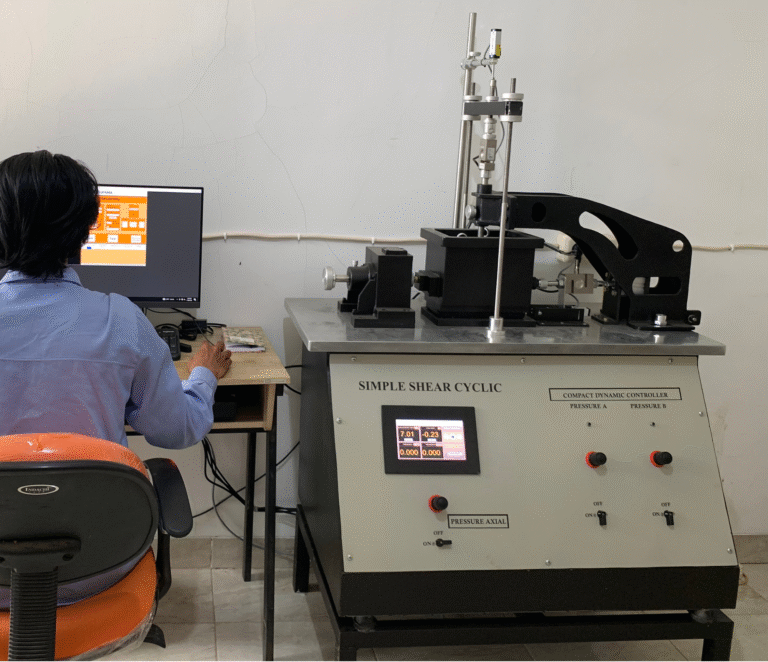CYCLIC SIMPLE SHEAR
Cyclic Simple Shear test is used to investigate the dynamic behavior of soils. It has some advantages over the cyclic triaxial testing as loading mechanism better simulates the earthquake conditions. Also the consolidation is anisotropic thereby simulating the at rest conditions in the field. The test is used to study the cyclic response of both the fine grained and coarse grained soils. The cyclic behavior can be investigated either by keeping the vertical stress constant or consolidated height constant during the cyclic loading.
International-Standard Premium Testing Services
The Simple Shear Cyclic Test is an advanced laboratory testing method designed to analyze the dynamic behavior of soil under repeated shear loading. This test is highly effective in simulating real field conditions resulting from seismic activity such as earthquakes, as well as cyclic loads from heavy machinery or high traffic intensity.
In this method, a soil specimen is placed within a simple shear test cell and subjected to controlled horizontal cyclic loads with specified frequency and amplitude. The data obtained is crucial for evaluating soil liquefaction potential, dynamic shear modulus, and the damping ratio of the soil material.
- Need and Scope
Cyclic Simple Shear test is used to investigate the dynamic behavior of soils. It has some advantages over the cyclic triaxial testing as loading mechanism better simulates the earthquake conditions. Also the consolidation is anisotropic thereby simulating the at rest conditions in the field. The test is used to study the cyclic response of both the fine grained and coarse grained soils. The cyclic behavior can be investigated either by keeping the vertical stress constant or consolidated height constant during the cyclic loading.
- Concept
Cyclic simple shear test has been predominantly used to study the liquefaction characteristics under constant volume drained conditions wherein the any change in normal stress is equivalent to the change in effective stress and is equal to the excess pore water pressure that would occur in an otherwise truly undrained test. Dynamic properties are evaluated in either undisturbed or reconstituted states by using either stress or strain controlled cyclic simple shear device.
- Experimental Setup
- Shear Load Cell
- Horizontal LVDT
- Vertical Load Cell
- Axial LVDT
- Axial LVDT (Long Range)
Our Laboratory Advantages in Simple Shear Cyclic Testing
✅ Rare and Specialized Equipment
One of the few laboratories in Indonesia equipped with Simple Shear Cyclic testing systems that comply with ASTM D6528 standards.
✅ Broad Soil Testing Capability
Able to test various soil types including sand, silt, and clay, whether in undisturbed or reconstituted form.
✅ Reliable, High-Accuracy Data
Digitally recorded test results provide precise, repeatable data for advanced design and seismic analysis.
✅ Skilled & Knowledgeable Team
Our engineers and technicians have extensive experience in cyclic and dynamic soil testing, ensuring professional execution and interpretation.
✅ Automated Test Control Systems
Fully integrated load and deformation control systems ensure consistent application of cyclic shear forces with minimal operator intervention.
Preparation and Methodology
The Cyclic Simple Shear (CSS) Test follows a rigorous procedure to ensure the accurate evaluation of soil behavior under repeated shear loading. This method is designed in accordance with ASTM D6528 and is ideal for simulating conditions similar to those caused by seismic activity or other dynamic forces.
- Specimen Preparation
- Saturation Process
- Anisotropic Consolidation
- Cyclic Shear Loading
- Monitoring and Data Acquisition
This structured methodology ensures that the Cyclic Simple Shear Test yields accurate and representative data for assessing dynamic soil properties—particularly in applications such as liquefaction potential evaluation, seismic design, and deformation analysis.

